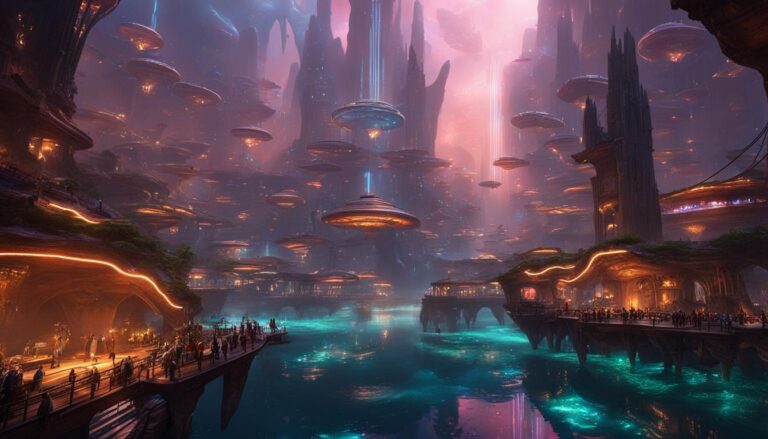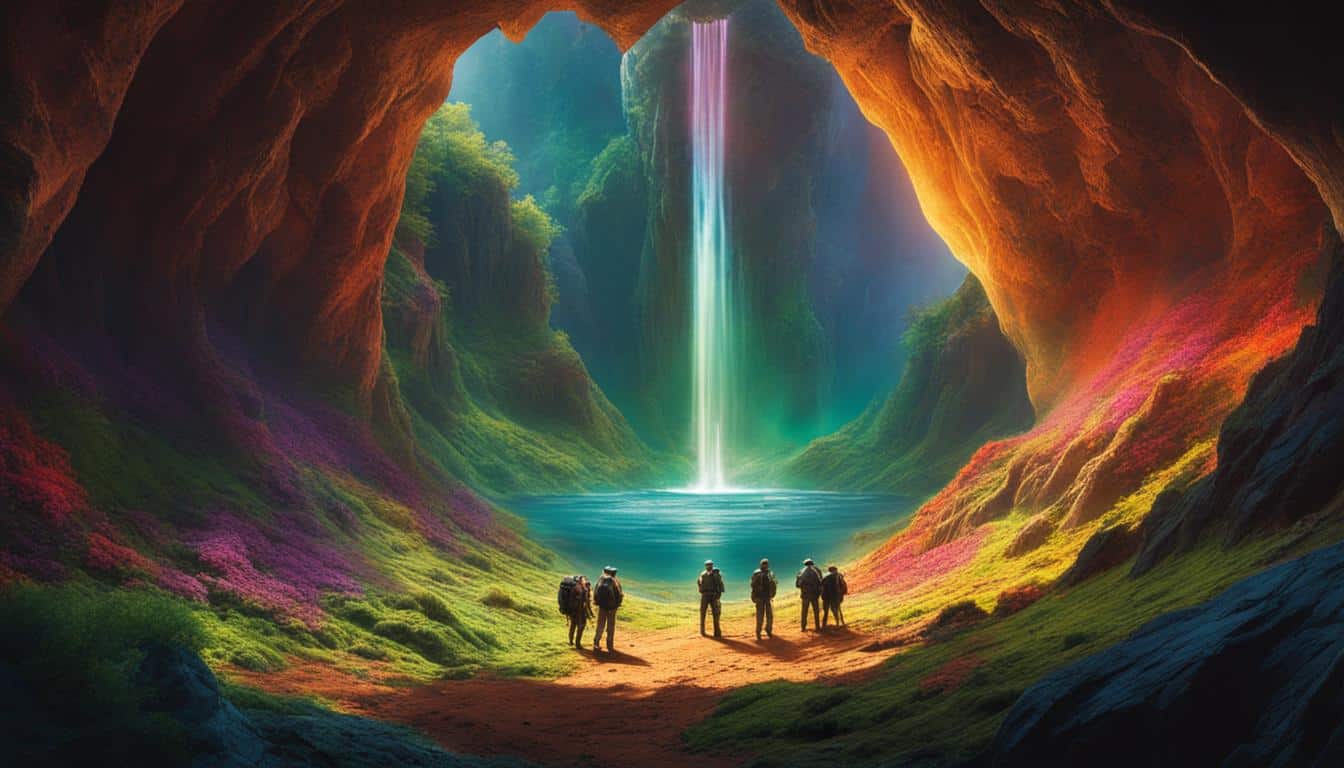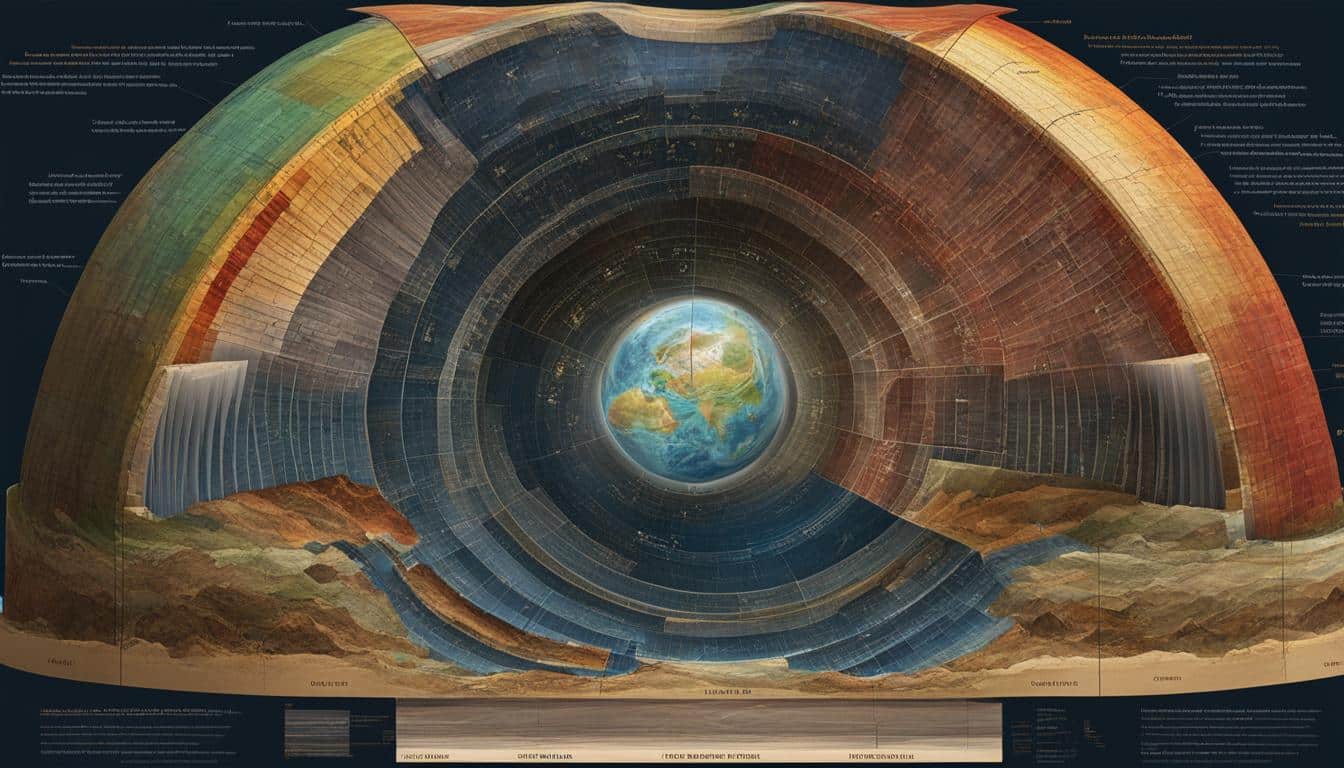The Hollow Earth theory is a captivating concept that has fascinated people for centuries. It proposes that the Earth is not a solid sphere but rather a hollow planet with a hidden world inside. This idea has inspired legends and myths, scientific hypotheses, and fantastic stories of subterranean civilizations. In this section, we will delve into the various ideas and hypotheses surrounding the concept of Hollow Earth.
Inner Earth, as it is also known, is believed to exist within the Earth’s outer crust, with entrances at the poles and other locations on the planet. The idea of a hollow planet has been a part of human mythology and folklore for centuries, with tales of inner realms and creatures lurking beneath the Earth’s surface.
But the concept of a Hollow Earth also has scientific hypotheses proposed to explain its possibility. Some scientists suggest that the Earth’s inner core may be hollow, with a secondary inner core inside it. Others propose that geological phenomena such as seismic waves and magnetic anomalies support the notion of a hollow planet.
Moreover, the Hollow Earth theory suggests that subterranean civilizations may exist within the hidden world. These civilizations are said to be technologically advanced and possess knowledge beyond our current understanding. Some claim that these subterranean societies have coexisted with humanity for thousands of years, influencing our culture and evolution.
As we continue our exploration of the captivating concept of Hollow Earth, we will examine both the historical and mythical origins of the theory, the scientific discourse surrounding its possibility, and the evidence and claims put forward by its proponents. Join us as we journey into the depths of the subterranean world and unravel the mysteries that lie beneath our feet.
The Historical and Mythical Origins
The concept of Hollow Earth has fascinated people for centuries, with stories of a mystical inner realm passed down through folklore, literature, and mythology. The idea of a hollow planet with a hidden world inside has captured the imagination of people across the world.
Mythical Inner Realms
One of the earliest mentions of a hollow earth dates back to ancient Greek mythology, where it was believed that the god Hades ruled the underworld beneath the earth. Legends from other cultures also refer to a subterranean world, including the Norse mythology of Svartalfheim, the Chinese legends of Diyu, and the Hindu stories of Patala.
“And beneath the earth, there were other gods, dwellers in the abyss, who enjoyed life of a sort. They were called Titans, and they were ruled by Kronos, the king of the abyss. It was said that when the world grew old, the Titans would break through the earth and re-emerge into the daylight world.”
Lore and Literature
The idea of a hollow earth continued to be explored in literature, with famous works such as Jules Verne’s 1864 novel “Journey to the Center of the Earth” and Edgar Rice Burroughs’s “Pellucidar” series. These stories captured the imagination of readers and sparked a renewed interest in the possibility of a world hidden beneath the earth’s surface.
The Hollow Earth Theory
While the idea of a hollow earth had been around for centuries, it wasn’t until the 17th century that it became a scientific theory. In 1692, English astronomer Edmond Halley proposed that the earth was composed of several nested spheres, with spaces in between where air and possibly life could exist. The theory was developed further by scientists such as Leonhard Euler and Sir John Leslie in the 18th and 19th centuries, who proposed that the earth’s crust was thin and the interior was hollow.
Hollow Earth in Scientific Discourse
The concept of a Hollow Earth has been debated and discussed by many scientists and researchers over the years. While it remains a controversial and unproven theory, there are several scientific hypotheses proposed to explain the possibility of a hollow planet.
One of the most prominent theories suggests that the Earth’s inner core is not actually solid, but rather a liquid outer core surrounding a central, empty space. This idea is based on seismic observations and experiments that have shown the inner core to be less dense than the outer core.
Another theory proposes that the Earth’s crust is actually a shell, with a vast open space in the center. This idea is based on the observation that the Earth’s surface is made up of several tectonic plates that fit together like a puzzle. Some scientists have suggested that this indicates a hollow space between the plates.
However, both of these theories have been met with criticism and doubts from the scientific community. Some argue that seismic observations can be interpreted in different ways, and that there is no definitive evidence to support the idea of a hollow Earth. Others point out that the Earth’s magnetic field and other geological phenomena are difficult to explain if the planet were indeed hollow.
Despite the lack of concrete evidence, the Hollow Earth theory continues to intrigue and fascinate people around the world. Some proponents of the theory believe that there may be a subterranean civilization living within the Earth’s interior, while others see it as a source of inspiration for science fiction and fantasy works.
The Mystery of Subterranean Civilizations
One of the most fascinating aspects of the Hollow Earth theory is the idea of hidden subterranean civilizations. Legends and myths from around the globe mention these mysterious societies, often depicted as advanced and highly intelligent, with their own distinct cultures and customs. Some even suggest that these civilizations have been in contact with the outer world for centuries, influencing human history in ways we cannot comprehend.
While there is no scientific evidence to support the existence of subterranean civilizations, proponents of the Hollow Earth theory point to various accounts and alleged sightings to validate their claims. For example, in the late 19th century, a wealthy entrepreneur named John Cleves Symmes Jr. embarked on a mission to find the entrance to the Hollow Earth, believing that he could establish contact with the advanced beings that lived there.
Another famous account comes from Admiral Richard E. Byrd, who allegedly flew over the North Pole in 1947 and encountered a land beyond the pole that he described as “the center of the great unknown.” Byrd claimed that this land was inhabited by a highly advanced civilization with aircraft that could fly from pole to pole in a matter of minutes, far surpassing anything the outer world had ever seen.
These accounts, while compelling, remain unverified, and many skeptics dismiss them as mere works of fiction. However, the idea of hidden civilizations continues to capture the public imagination, inspiring countless works of literature, film, and art.
The concept of subterranean civilizations is not limited to the realm of fantasy and science fiction. Anthropologists and archaeologists have long been fascinated by underground cities and societies, such as the Derinkuyu in Turkey and the Cappadocian cave dwellings in Greece. These structures showcase the ingenuity and resourcefulness of ancient civilizations, and offer a glimpse into a world that was vastly different from our own.
Whether or not subterranean civilizations truly exist, the idea of hidden worlds and underground societies continues to captivate people’s imaginations. The Hollow Earth theory offers a tantalizing glimpse into a mysterious and enigmatic world that may never be fully understood.
Journeying into the Cavern World
In this section, we will explore the fascinating idea of a hidden cavern world within the Hollow Earth. According to believers of the theory, this underground realm is said to contain vast networks of tunnels and subterranean cities.
Despite the lack of concrete evidence supporting the existence of the cavern world, many people are drawn to the allure of the unknown. There have been numerous accounts of alleged sightings and encounters with subterranean beings, adding fuel to the belief in the Hollow Earth theory.
The idea of underground cities is not a new one. In fact, there are many historical records of ancient civilizations creating elaborate underground dwellings. One such example is the ancient city of Derinkuyu in Turkey, which is thought to date back to the 7th or 8th century BCE.
The idea of a cavern world may seem far-fetched to many, but it continues to captivate the minds of those who believe in the Hollow Earth theory. Whether it is a fanciful myth or a hidden reality, the idea of an underground world filled with mystery and wonder is a timeless fascination.
Unraveling the Secrets of the Underground
As the concept of Hollow Earth continues to intrigue scientists and enthusiasts alike, various expeditions have been undertaken to explore the unknown depths beneath our feet. The quest to uncover evidence supporting the existence of a subterranean world has led to several fascinating discoveries over the years, along with heated debates and skepticism.
One of the most significant studies conducted in recent times was the 2014 Black and Bloom Expedition to Greenland. The research team, led by glaciologist Martin Siegert, used radar and other techniques to explore the ice sheets and glaciers of the region. They discovered a complex system of tunnels and canals beneath the ice, indicating the existence of a subglacial water network that had never been explored before.
Other significant discoveries include the Derinkuyu underground city in Turkey, the system of tunnels and caves in Shanxi, China, and the Wieliczka Salt Mine in Poland (pictured below).
While these discoveries offer evidence of the existence of a subterranean world, skeptics argue that they do not necessarily support the idea of a completely hollow planet. Furthermore, the scientific feasibility of a hollow earth continues to be a topic of debate among geologists and physicists.
“The concept of a hollow Earth was born out of superstition and mythology, not science. While it is fascinating to imagine a hidden world beneath our feet, we should not confuse it with reality.” – Lisa Randall, physicist
Despite the skepticism, the allure of the unknown continues to draw explorers and adventurers to the depths of the earth. Who knows what other secrets and mysteries lie hidden in the underground realm that we have yet to uncover?
Debunking the Hollow Earth Theory
While the Hollow Earth theory may be captivating, it has been met with skepticism and criticism by many in the scientific community.
One of the most significant challenges to the concept is the fundamental principles of physics. The idea of a hollow planet goes against the laws of gravity, which would require a massive amount of mass to be concentrated at the planet’s center to maintain the gravitational pull. Additionally, seismic waves, which are vibrations that travel through the Earth’s interior, provide direct evidence of a solid core.
Another argument against the Hollow Earth theory is the lack of evidence to support the existence of subterranean civilizations. Despite claims of eyewitness accounts and ancient texts, there has been no conclusive evidence to prove the existence of a hidden world within the Earth.
Moreover, scientific theories have already provided alternative explanations for geological phenomena such as volcanic activity and earthquakes, making the need for a Hollow Earth unnecessary.
The Bottom Line
While the Hollow Earth theory may continue to fascinate conspiracy theorists and fiction writers, the scientific evidence against its existence remains overwhelming. As scientists continue to explore the depths of the Earth, we may uncover new secrets and mysteries, but the existence of a hollow planet is not likely to be among them.
The Modern Perception of Hollow Earth
The concept of Hollow Earth has been a source of inspiration for many creative works, from literature to movies and conspiracy theories. Today, the idea of an inner world continues to fascinate people around the globe.
Many authors have used the concept of Hollow Earth as a premise for their stories. For example, Jules Verne’s classic novel “Journey to the Center of the Earth” tells the tale of a professor who leads an expedition into an extinct volcano and discovers a hidden world beneath the Earth’s surface. Similarly, H.P. Lovecraft’s “At the Mountains of Madness” involves a group of explorers who uncover a lost civilization in Antarctica, featuring creatures and structures that defy explanation.
Modern cinema has also embraced the Hollow Earth concept. In the movie “Kong: Skull Island,” an expedition team travels deep into the unexplored territory of the island and discovers a subterranean world filled with exotic creatures and ancient ruins. Additionally, the movie “Pacific Rim” features giant robots battling monsters from another dimension that emerge from the Earth’s core.
Conspiracy theorists have also adopted the idea of Hollow Earth as a possible explanation for a variety of phenomena, such as UFO sightings and mysterious disappearances. Some assert that a secret underground society exists within the Hollow Earth, which directs the course of human events from behind the scenes.
The modern perception of Hollow Earth is multifaceted, encompassing myth, legend, science, and imagination. While the scientific community largely rejects the theory, the idea of a hidden world beneath our feet still captures the human imagination, inspiring us to explore the unknown and dream of what might lie beyond the surface of the Earth.
Conclusion
In conclusion, the concept of Hollow Earth has been a topic of fascination for centuries. From mythical tales and legends to modern scientific hypotheses, the idea of a subterranean world continues to capture our imagination. While there is no concrete evidence to support the existence of a Hollow Earth, the possibility remains a subject of ongoing study, exploration, and debate.
The notion of subterranean civilizations and underground cities may seem far-fetched, but the history of human civilization has shown that we are constantly discovering new things about our planet. The search for answers and the unraveling of the secrets of the underground realm are ongoing, and who knows what we may discover in the future.
Reflecting on the Hollow Earth Theory
Reflecting on the Hollow Earth theory, one cannot help but appreciate the human curiosity and creativity that have fueled the idea. From ancient mythology to modern pop culture, the concept of a hidden world beneath our feet has captured our imagination in countless ways. While the scientific evidence may not support the notion of a hollow planet, the idea remains a testament to the wonders and mysteries of our planet and the universe beyond.
Thank you for joining us on this exploration of the intriguing concept of Hollow Earth. We hope you have enjoyed the journey and gained a deeper understanding of this enigmatic theory.



